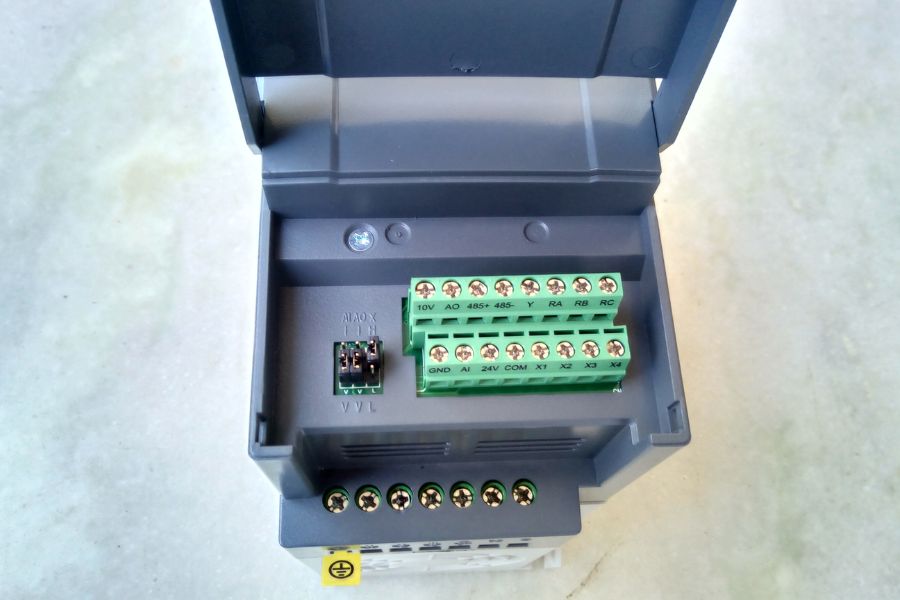VFDs have gained significant importance in various industries due to their ability to optimize energy consumption, improve motor performance, and enhance system efficiency. Organizations widely use them in HVAC, industrial machinery, pumps, fans, and conveyor systems.
By understanding how VFDs operate, we can better appreciate their impact on motor control and energy efficiency. So, let’s begin by examining the definition and significance of VFDs, followed by an overview of the essential components involved in their operation.
Working Principle Of A Variable Frequency Drive
Basic Functions And Objectives Of A VFD
A variable frequency drive (VFD) serves several key functions in controlling the speed and torque of an electric motor. Its primary objective is to convert the fixed frequency alternating current (AC) power supply into variable frequency AC power. By adjusting the frequency and voltage, a VFD allows for precise control over the motor’s rotational speed, providing flexibility and efficiency in motor operation.
Conversion Of Fixed-Frequency AC Power To Variable-Frequency AC Power
The working principle of a VFD involves the conversion of the incoming fixed-frequency AC power into variable-frequency AC power. The inverter section converts the DC power back into AC power with a variable frequency supplied to the motor.
Role Of Key Components In The Operation Of A VFD
Several key components play a crucial role in the operation of a VFD. The rectifier section, typically consisting of diodes or thyristors, converts the incoming AC power into DC power. The DC bus capacitors store and filter the DC power, providing a stable voltage source for the inverter section.
The inverter, composed of insulated gate bipolar transistors (IGBTs) or power transistors, converts the DC power into variable frequency AC power. This then reaches the motor. Control circuits and microprocessors also govern the VFD’s operation, allowing for precise speed and torque control.
Understanding the working principle of a VFD and the functions of its key components provides insights into its capabilities and advantages in motor control.
Advantages Of Using A Variable Frequency Drive
Energy Savings And Optimization Of Motor Operation
One of the significant advantages of using a variable frequency drive (VFD) is its ability to achieve energy savings and optimize motor operation. By controlling the motor’s speed and torque according to the load requirements, a VFD ensures that it operates at its most efficient point.
Speed Control And Motor Parameter Monitoring
Another advantage of VFDs is their excellent speed control capabilities. With a VFD, you can easily adjust the motor’s rotational speed. This allows for precise control and flexibility in various applications.
The ability to change speed on the fly enables smooth starting and stopping of the motor, reducing mechanical stress and improving overall system performance. VFDs often come with built-in motor parameter monitoring features, allowing operators to monitor and analyze critical motor parameters such as temperature, current, and voltage, ensuring safe and reliable operation.
Read Also: All About Air Conditioning Repairs in Andrews, TX
Reduction Of Mechanical Stress And Increased Equipment Lifespan
A VFD can help reduce mechanical stress on the motor and connected equipment. You can minimize sudden mechanical shocks and torque spikes by gradually ramping up the motor’s speed during startup. This will help to reduce wear and tear on the motor and mechanical components.
The ability to control acceleration and deceleration rates also contributes to smoother operation and extended equipment lifespan. Additionally, the precise control provided by a VFD helps eliminate issues such as water hammering and pressure surges in pumping systems, further protecting the equipment from damage.
By taking advantage of these benefits, users can improve energy efficiency, enhance control flexibility, and extend the lifespan of their motors and equipment. The next section will explore the practical applications of variable frequency drives across various industries and sectors.
Applications Of Variable Frequency Drives
Industries And Sectors That Uses VFDs
Variable frequency drives (VFDs) find extensive applications across various industries and sectors. Some of the industries where they commonly use VFDs are as follows:
- HVAC (Heating, Ventilation, and Air Conditioning): They use VFDs in HVAC systems to control the speed of fans and pumps, allowing for precise temperature and airflow regulation.
- Water and Wastewater: VFDs play a crucial role in water and wastewater treatment processes, controlling the speed of pumps and blowers to match the fluctuating demand and optimize energy consumption.
- Manufacturing and Industrial Processes: People widely use VFDs in manufacturing plants and industrial processes to control the speed of motors in equipment such as conveyors, mixers, compressors, and machine tools.
- Oil and Gas: People use VFDs in oil and gas applications for controlling pumps, compressors, and fans, offering energy-efficient operation and precise control in demanding environments.
- Renewable Energy: VFDs are popular in renewable energy systems. People use them as wind turbines and solar power systems to convert variable frequency input into grid-compatible power output.
Specific Examples Of VFD Applications
Some specific examples of VFD applications include:
- Pumping Systems: VFDs are present in pumping systems for water supply, irrigation, wastewater management, and firefighting, allowing for optimized control of pump speed and flow rate.
- HVAC Systems: VFDs are utilized in HVAC systems for controlling the speed of fans, pumps, and compressors, enabling energy-efficient climate control in commercial buildings and residential complexes.
- Conveyor Systems: Organizations use VFDs in conveyor systems for precise control of motor speed, allowing for flexible and efficient material handling in industries such as manufacturing, mining, and logistics.
- Machine Tools: People merge VFDs into machine tools such as milling machines, lathes, and CNC machines. They do this to control the speed and torque of the motor, ensuring accurate and efficient machining operations.
Benefits Of Vfds In Different Application Scenarios
As technology advances, we can expect VFDs to play a more significant role in achieving energy efficiency and process optimization. Their ability to precisely control motor speed, reduce energy consumption, and enhance equipment performance makes them indispensable in modern industrial and commercial settings.
By harnessing the power of variable frequency drives, industries can achieve greater control, efficiency, and sustainability in their operations, leading to cost savings, reduced environmental impact, and improved productivity. Consult trusted suppliers and industry professionals for high-quality variable frequency drives and expert guidance in selecting the right solution for your specific needs.
The use of VFDs in various application scenarios provides several benefits, including:
- Energy Efficiency: VFDs enable significant energy savings by adjusting motor speed to match the required load. This avoids unnecessary energy consumption associated with fixed-speed motors.
- Process Control and Flexibility: VFDs offer precise control over motor speed. It allows accurate process control and the ability to adapt to changing operational requirements.
- Equipment Protection: VFDs help protect equipment by reducing mechanical stress, preventing abrupt starts and stops, and offering overload protection features.
- Maintenance and Cost Savings: VFDs can extend the lifespan of motors and equipment. They can reduce maintenance requirements and operational costs associated with frequent repairs or replacements.
In conclusion, variable frequency drives (VFDs) are crucial in optimizing motor performance. They can also enhance energy efficiency, and improve control in various industrial and commercial applications. By converting fixed-frequency AC power to variable-frequency AC power, VFDs enable precise speed control. Furthermore, they reduce energy consumption, and extend the lifespan of motors and equipment.
Bottom Line
Throughout this article, we have discussed the working principle of VFDs. We have highlighted the conversion process of fixed-frequency AC power to variable-frequency AC power. We have also talked about the role of key components in their operation. Additionally, we have also explored the advantages of using VFDs. These include energy savings, speed control, and reduction of mechanical stress, leading to increased equipment lifespan.
In summary, variable frequency drives are essential for optimizing motor control and achieving energy efficiency in various applications. By understanding their working principle, advantages, and applications, businesses can harness their benefits to drive success in today’s competitive landscape.
Additionals:




























